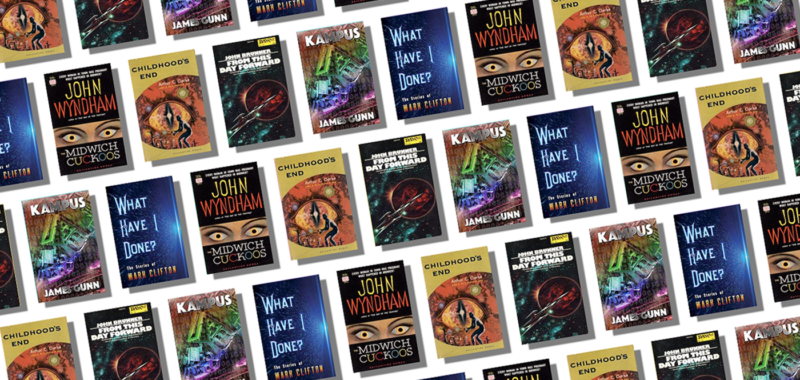An odd quirk of history: Although the generation that produced the Baby Boomers was enthusiastic about producing an abundance of children, or at least the process that leads to an abundance of children, many seemed ambivalent about their actual progeny. A number of male SF authors wrote works seemingly inspired by the alarm they felt while encountering the tsunami of Boomer kids1. Here are five examples.
“Star, Bright” by Mark Clifton (1952)
Pete Holme realizes that his young daughter Star has an exceptional IQ, even higher than his. From personal experience, Star’s father knows that superlative intelligence is often a curse. Bright people are so often pariahs. They are also uncomfortably aware of matters beyond the comprehension of their cheerfully lackwit neighbors. Pete sets out to ensure that Star is, if not happy, then no more miserable than she absolutely has to be.
Star has something Pete never had, a peer. Young Robert is as bright as Star, a natural ally in a world dominated by dullards like the majority and the occasional half-bright person like Pete. Together, the children can travel to a better world… but poor Pete will not be accompanying them.
I forgot until I reread this how depressed Pete Holme is, what with being socially isolated, a widower, and the single father of a child far brighter than he is. To his credit, Pete is nothing but supportive of Star.
Childhood’s End by Arthur C. Clarke (1953)
The US/Soviet space rivalry is brought to an abrupt and permanent end by the arrival of alien Overlords. The Overlords swiftly, bloodlessly conquer Earth. War is ended, prosperity made global, and aside from the minor issue of human autonomy, a golden age begins. A very brief golden age, as it is merely the means to an end.
The Overlords being diplomatically oblique about the purpose behind their sudden annexation of Earth, humans can be forgiven for thinking that the Overlords invaded to save humans from atomic self-destruction. Or to save humans at all. The Overlords are interested the generation to come, beings that might be said to be children but are (to their parents’ alarm) not human at all.
What the Overlords achieve on Earth is open to interpretation. Were they playing a role in Stapledonian psychic orthogenesis? Or were they providing a snack for their cosmic god? Either way, the parents had reason to be concerned.
The Midwich Cuckoos by John Wyndham (1957)
An unidentifiable object suddenly appears in the town of Midwich and everyone within a two miles radius falls asleep. A day later, the object vanishes and the population wakes. A few unfortunates perished from secondary effects like exposure, but otherwise the locals seem unharmed. Then they discover that every fertile woman in the affected area is pregnant.
The sixty-one children who result appear human. Subsequent events reveal that the Children possess powers beyond human ken, that the boys all share one mind, as do the girls. Furthermore, the Children have no particular regard for the species used to bring them into being. Once the Children are adult and have no further need for their hosts, what fate will befall humans? And is there anything humans can do to save themselves?
Readers interested in what’s going in here should search the term “brood parasitism,” although they should be aware that anything involving parasitism is generally the stuff of nightmares.
An interesting detail: We learn that Midwich wasn’t the only town targeted. We are given a list of communities of affected communities. They were all isolated and easy to overlook. Odd that a British author would lump a UK rural town with villages and settlements in Mongolia, the Canadian Arctic, Australia, and Siberia.
“Wasted on the Young” by John Brunner (1965)
Hal Page is something even more terrible than some precious, nigh-alien child. Hal is an example of what a cosseted, pampered child can grow into. Hal has spent his short life shirking responsibility while indulging his every whim. Not only is Hal a drain on society, he is an inspiration to other would-be lay-abouts.
Hal is quite aware that someday a bill will come due, that society will expect that the luxuries of today be paid off with the labor of tomorrow. Hal has a cunning plan to avoid paying his bill… but it’s not cunning enough.
Kampus by James E. Gunn (1977)
Once respectable colleges are overrun by student hordes, full of bomb-tossing radicals prone to political absurdities, violence, and libidinous excesses. All hardworking professors can hope to do is keep their heads down and survive as long as they can before the students turn on them.
The students have developed a novel method to quickly and easily decant knowledge from their elderly professors. It is fatal to the unfortunate elderly scholars.
Gunn was, like the scholarly victims in his novel, a pre-Boomer academic, which I sense may have influenced his reaction to professors being transformed into educational smoothies for the convenience of lazy undergrads. At least the spicy autocomplete so popular on campuses these days leaves professors unharmed.
These are only a few of the stories created by pre-Boomer authors alarmed by rising generation—the children of the late 1940s and the 1950s, the teens of the 1960s and 1970s, and the young adults of the 1980s and beyond. Perhaps I overlooked your favorites2. Feel free to mention them in comments below.

